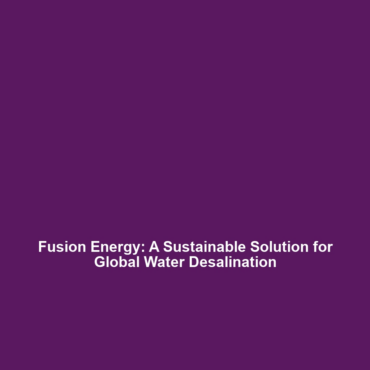Fusion Energy: A Sustainable Solution for Global Water Desalination
Introduction
As the world grapples with escalating water shortages, the search for innovative solutions becomes ever more urgent. Fusion energy, the process that powers the sun, presents a promising opportunity to generate the immense amounts of energy required for large-scale water desalination. By harnessing this powerful energy source, we can not only provide fresh water for drought-stricken regions but also contribute to a more sustainable future. This article explores the significance of fusion energy in addressing global water shortages while promoting sustainable practices.
Key Concepts
Understanding Fusion Energy
Fusion energy occurs when atomic nuclei combine at extremely high temperatures, releasing energy in the process. This contrasts with fission, where nuclei split apart. The potential of fusion lies in its abundant fuel supply, safety, and minimal environmental impact, making it an attractive option for large-scale energy production.
Water Desalination Explained
Desalination refers to the process of removing salt and minerals from seawater to make it suitable for human consumption and irrigation. Traditional methods of desalination are energy-intensive, thus limiting their feasibility in many regions. However, with the application of fusion energy, these processes could become significantly more efficient and sustainable.
Applications and Real-World Uses
The applications of fusion energy in water desalination could revolutionize the way we address water scarcity. Some significant real-world uses include:
- Direct Energy Supply for Desalination Facilities: Fusion energy could directly power desalination plants, reducing operational costs and reliance on fossil fuels.
- Integration with Renewable Energy Systems: Fusion technology can complement other renewable energy sources, creating a stable energy supply for desalination efforts.
- Research Initiatives: Ongoing research into fusion can lead to innovative technologies that improve the efficiency of desalination processes.
Current Challenges
Despite its promise, several challenges hinder the implementation of fusion energy in large-scale water desalination:
- Technological Barriers: Current fusion reactors are experimental and not yet commercially viable.
- High Initial Costs: The investment needed to develop fusion technologies can be prohibitively high.
- Public Perception: Misunderstandings regarding fusion technology may reduce public support and funding opportunities.
Future Research and Innovations
Future research in fusion energy aims to unlock new innovations that could enhance water desalination methodologies. Key areas of focus include:
- Advanced Reactor Designs: Developing compact fusion reactors that can be deployed alongside desalination plants.
- Breakthrough Fuel Sources: Research on alternative fuels that could lower the costs and complexities associated with fusion energy production.
- Enhanced Collaboration: Partnerships between governments and private sectors to fund and innovate fusion energy projects.
Conclusion
In summary, fusion energy holds the key to transforming the way we approach large-scale water desalination, addressing global water shortages with a sustainable edge. As research progresses, the potential to integrate fusion technology into practical applications grows, promising a future where clean water is accessible to all. For further reading on fusion technology and its implications, visit our related articles on fusion advancements and desalination technologies.









